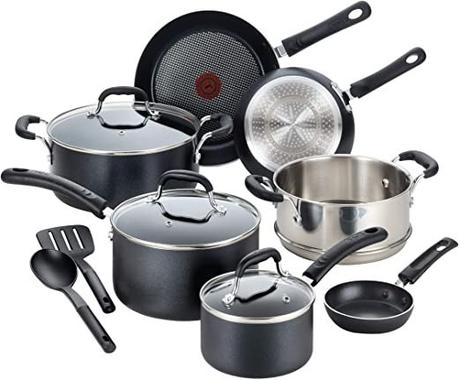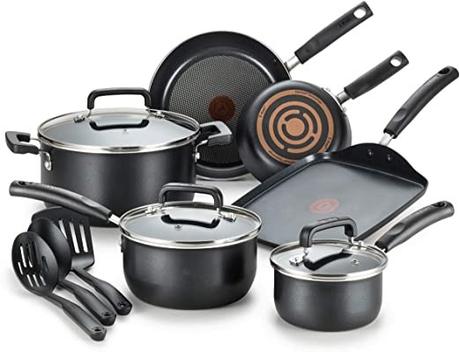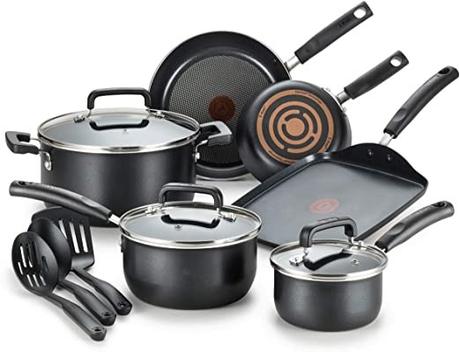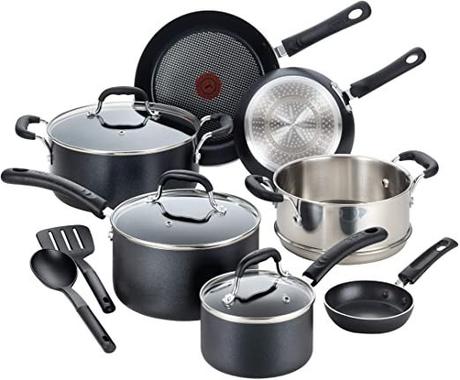We all crave delicious food, but how do you know that the nonstick cookware you’re using is as good as the food you intend to cook?
If you are a chef or just a food enthusiast who enjoys cooking, you have to make a decision on which cookware is the best. Either way, you know that the pan you cook with is just as important as the recipe.
The dilemma comes from choosing between traditional pure stainless steel or ceramic nonstick cookware. For a chef like me, that’s an easy answer. Both pans are great – it just depends on what you are cooking. This is because each one has different heat conduction.
In reality, there is no perfect pan. Each type has its upsides and downsides. In this article, I will give you a few tips on which brands make the best nonstick pans. I will also touch on the stainless steel pans. In addition, it is good to touch on non-toxic pans.
But first, what really makes a pan nonstick? The answer is commonly known as Teflon, or tetrafluoroethylene in nerd speak. It is often used to make nonstick cookware, it’s not stained, and it’s water resistant.
Why Would You Want To Use Nonstick Pans?

Here are just a few reasons:
- You can clean it easily.
- Food doesn’t stick to the pan, which makes cooking much easier.
- You can reduce the use of cooking oil or butter.
- They have an elegant look while you’re cooking with them.
What to consider when choosing nonstick cookware products
When you’re picking nonstick cookware products, there is the budget to consider, for starters. This means your chances of buying superior quality will be affected. You need to save up and ensure that what you buy will be worth your while.
You also need to consider your health. The most important thing to think about when selecting cookware is if it will support your everyday food consumption. The type of nonstick cookware you use should match your health values.
Your style of cooking also matters. If you are more into searing and browning steaks, you may want to stick to the stainless steel cookware. However, if you are more into light breakfasts like eggs and pancakes, you may consider nonstick cookware.
Lastly, the type of material used to make the pan matters too. It’s Physics 101 – you need to think of heat distribution. Nonstick cookware varies when it comes to material and heat conduction. Depending on whether you cook with gas or electricity, you may need to re-evaluate your options.
Let’s do it!
Stainless steel pots and pans
Some people consider stainless steel to be traditional. On the contrary, I consider them to be a good choice. Think about it: your stainless steel pots and pans can go into a fiery oven and come out with just minor burns. It just takes some simple scrubbing in getting them back to original form. Stainless steel pots and pans are also good when it comes to searing and roasting. They bring out a crusty natural fresh aroma of the food (also known as the Maillard reaction). They are also good for simmering as they can withstand heat for a long time.
Stainless steel pots and pans are used in all cooking generally. If my personal history serves me well, I would say they fed me for most of my childhood. They are relatively affordable and durable. The only downside to stainless steel pots and pans is the hard scrubbing when they end up burned. Plus, if the handle is burned, it may burn your hand too if you’re not careful.
Stainless steel pots and pans are a must-have in any kitchen. They can go to places (ovens and screaming hot fires) that many nonstick cookware would never be able to go.
Masterclass premium cookware
Masterclass’s range of products is overwhelmingly top tier. I have tried them firsthand, so I know they are well made. Their nonstick cookware is made from a high quality and durable hardened cast aluminum.
Due to their superior quality, these pots and pans have been found to outlast other conventional nonstick cookware. Masterclass premium cookware has a nonstick interior, which makes it easy for food to release. It is also easy to clean them.
Non-toxic cookware

Everyone has an opinion on nonstick pans and pots. Even though nonstick cookware is elegant and efficient cookers, some critics will say that it is actually poisonous. To be clear, there was an element of truth to this idea some years back.
However, with new knowledge and updated technology, there have been many improvements to nonstick cookware. For instance, they minimized the risk of poisoning through Teflon (a synthetic chemical made of carbon and fluorine atoms that forms the nonstick layer). Teflon causes flu-like symptoms, which last up to three days. Many companies are testing and publishing the results of their findings, as a measure of reassuring their customers. They are also finding new and advanced ways of using non-toxic cookware.
Of course, nonstick cookware is here to stay. They say what you do not know does not hurt you. However, that does not mean you put your health, and those of your family at risk. It is better to be safe than sorry.
Small ingestions of flakes from nonstick cookware are considered not dangerous. Non-toxic cookware has got you covered. There are many options to choose when it comes to non-toxic cookware. One good recommendation is to use stainless cookware.
There are some few tips I can give to ensure you are safe.
- Do not preheat your pan over scorching heat. You do not want the fumes to affect you.
- Ensure your kitchen is well ventilated or has fans.
- Never put your no-stick pan into an oven above 400°F.
- Ensure you use medium heat when cooking.
- Go for the heavier pans as they do not overheat easily.
- Avoid cooking with chipped pans.
Sure, these tips are not 100% bulletproof, but why risk it? There are also other better choices of nonstick cookware. Most of them are of relatively high prices but again who said good things come cheap?
Are there safe nonstick pans?
Of course! In fact, there are a ton of them. Some examples include ceramic cookware. Although there’s been less research done on them, personal experience has shown me that they bring something useful to the table. Be careful when purchasing them as some can be of poor quality. Plus, not every company is genuine about their products. Some want to have an easy buck.
With the ever evolving and developing technological advancement, there sure will be a time to have the most superior quality of nonstick cookware. As for now, take your time and find the best place to get your cookware.
What Makes Nonstick Cookware?

These products are engineered so that foods can’t stick to their surfaces. The material used to make the nonstick cookware is called polytetrafluoroethylene, also known as Teflon.
Of course, not all-nonstick cookware is made of Teflon. Some other materials used to make nonstick products are:
Stainless steel:
Stainless steel is mostly found in cookware such as pots and pans. Stainless steel cookware is made by adding two metals that are nickel and chromium. They are impervious to corrosion by acids, which ensures that anything cooked in them isn’t contaminated.
The pros of stainless steel
- They are dishwasher safe.
- They are long-lasting, so they make for a good investment.
- Their ability to conduct heat fast is amazingly good, ensuring food cooks fast and evenly.
- They are non-reactive to acids. You can cook any type of food without worrying.
The cons of stainless steel
- Finding quality stainless steel can be quite difficult and expensive.
- You must take care when heating foods as they conduct very fast, which can make things burn.
Stainless steel pots and pans come in handy. They can be used to cook almost anything, as they are non-reactive. It is a good choice to go for them. You need to note that when buying them, ensure they have an aluminum core or copper core. This adds to their heating up very fast.
Aluminum:
This material makes light and beautiful cookware on its own. It is also a good conductor of heat, meaning it cooks evenly. However, aluminum cannot make cookware on its own. This is because it is very corrosive with some food acids. This shortcoming is controlled through the addition of nonstick material and clad stainless steel in a process called adonization, which hardens the surface and gives the pan a dark gray color.
Aluminum is certainly a good option, as long as it is anodized. This will give you more service years to come.
The pros of aluminum
- They are anodized and have nonstick capabilities. Food will not stick to your pan.
- They are generally durable and scratch resistant. That means you can use even metallic spoons to cook without worrying.
- They are good conductors of heat. They are also used in ovens if they have metallic handles.
The cons of aluminum
- They are generally not dish washable.
- They are also a bit expensive to buy.
Carbon Steel:
If you have a wok pan or a skillet, it is probably made of carbon steel. This material has slow heat conductivity, but can withhold high heat. Carbon steel needs to be seasoned (oiled) regularly because it develops a good nonstick interior.
The pros of carbon steel
- Are relatively affordable to start with.
- Long lasting compared to other nonstick cookware.
- Can cook almost everything in the kitchen.
- They are nonstick in nature only if they are seasoned well and frequently.
- Light in weight and therefore easy to handle. For those who love sautéing it’s a good choice for them.
The cons of carbon steel
- They require continuous seasoning which is frequent.
- They are not dish washable and hence you have to put some effort in cleaning them.
- Similarly, to cast iron, they are not used for boiling water.
Cast iron:

Unfortunately, it is a poor conductor of heat. The advantageous thing about them is that they take time to heat and cool down. This can be advantageous to those who like their food warm. Combined that it is very durable even in its natural state, the Dutch have used them in making ovens and griddles.
Pros of using cast iron
- The probability of it outliving you is very high if only you take good care of it.
- They are relatively cheap
- Once they get hot, they cook evenly. Added that it retains heat long, it is a good choice, as your food will stay warm throughout.
- They can be used in the oven depending on the handle.
- If seasoned well, they act like nonstick cookware and food releases easily.
The cons of using cast iron
- It is time consuming when it comes to cleaning and maintaining.
- Due to its nature (having iron), it reacts with acidic foods and produces iron. Even though iron is good for the body, it is not healthy to everyone.
- Funny enough, it is never used to boil water as it may start to rust.
- They are mostly heavy. Many novices may find using them tiresome. On the brighter side you can consider it as a gym of some sought.
- As much as they get very hot, they can be very dangerous especially if the handle is cast iron also. This may cause serious injuries.
Non-Toxic Nonstick Cookware With Glass Tops
Glass stove tops have become a new trend and these are used everywhere. Therefore, when you buy nonstick cookware, you need to consider this fact as well.
Material
There is a great debate on what material should be used with the glass top stoves and what not to. Stainless steel is durable metal but it does not provide all the benefits that you get from nonstick. As a good conductor of heat, aluminum results in cookware that conducts heat faster than any other material. Porcelain and copper bottom pans are also recommended but they also need a lot of care about the heat. Overheating the pan may result in the destruction of your stove by these metals. A smooth bottom pan of carbon steel is a good option.
Cast iron is a conflicted material to be used on a glass stove. Used on medium flame, cast iron can work best for the glass top stove. Although it takes a while to get the heat up, many people love to use it as it can hold heat for a longer time. It is best for slow cooking and even deep-frying. The problem with this material is that it can get rust and stain quite easily. This can be dangerous for your stave surface. If you can properly handle it and keep it in good form, then you should go for cast iron. Otherwise, it can be a bad option if you are not careful enough.
Weight
Weight is another important factor for your nonstick cookware. The pan must neither be too heavy to break your glass nor too light to be difficult to keep steady during cooking. If the pan is heavy, it will have more direct contact with the surface that makes it a better conductor of heat.
Shape and Size
Most recommended shape of the cookware is a flat bottom. As the cookware needs to touch the surface to get heat, hence the flat surface is the best option. It will have direct and maximum contact with the surface of the glass top stove. Flat bottom pans usually have a smooth surface that also saves your stove surface from being scratched.
Frequently Asked Questions about Nonstick Cookware

- My stainless cookware is discolored.
This usually happens when the pan has overheated with something in it. You unfortunately got distracted and forgot. You will find the pan burnt and discolored. After washing, it may not come out immediately but you can use a stainless wire to scrub off the stain
- Are stainless steel handles prone to heat?
Most are tubular and cannot conduct heat. On the other hand, stainless steel is a poor conductor of heat and takes a long time to get hot. Better sorry than sorry is what I would recommend. Use kitchen gloves to hold the handles.
- Do I need to season my nonstick cookware?
It is not. I should however insist that you wash the cookware with warm soapy water on first use. This will remove any dust particles that may have accumulated on the surface. Also, dry the product dry before use.
- Is my nonstick cookware safe for everyday use?
Generally, yes. Again check for manufacturers and government seals that ensure due diligence has been done. This will help you when raising liability issue or warranties.
- What is making my nonstick cookware sticky?
This may be caused by the use of high heat during cooking. It is recommended that you use moderate heat in your cooking. Extreme heat may cause flaking in some nonstick cookware if that item is not made to be used in high heat. It is advisable to clarify with your seller.
- Is my nonstick cookware harmful to my pets?
Considering some pets such as birds have a sensitive respiratory system, research has shown that the fumes may harm them.
- How would I tell if my cookware is dishwasher safe?
Product information is provided on the cover of the product. Also, confirm with your seller or the company for clarity. In addition, check whether metal is made of safest cookware. Meaning you can use metal spoons to cook with no effect of scratching.
- How do I clean my nonstick cookware?

By using soft nylon and warm soapy water. It will remove any grease or food, which may burn on the next use. In case, it does not come off, use a mild mixture of water and vinegar and put it on warm. Let cook for a few minutes and wash as instructed earlier. This ensures the product will last longer. Despite the fact that some cookware is dish washable, keep in mind that some detergent and steaming water will be harsh to the nonstick coating. This will make it deteriorate and not live long. Mind you, do not use any steel wool to scrub your pan.
- What could be the problem when there is an odor?
This mostly occurs when you are using high heat in cooking. You may need to dial down and use moderate heat. You do not want to eat food, which has a funny smell due to smoke.
- Can I use my nonstick spray on nonstick products?
A big NO. This builds up an invisible layer on your nonstick pan and will cause food to stick. This is because most of the aerosols burn at low heat, and will damage your nonstick pan. It will also void the warranty on your product. As we have been saying nonstick cookware is an investment, and you do not want to destroy your investment.
Conclusion
The research on nonstick cookware is understandably important. This is because many people have more resources and information. More people are again mindful and keen on their health matters. More and more research is being done to improve and find better solutions in the cookware world. The truth is nonstick cookware is the new way for cooking. It is wise to use care and while using and maintaining these products.
Nonstick cookware is one the greatest revolutions in the kitchen. Just going to any kitchen and finding nonstick is cookware is a clear indication, kitchens have come from afar. The elegance and sophistication they bring is a pride to anyone who uses them. Again, they have made life easy in terms of cleaning and saving household costs.
